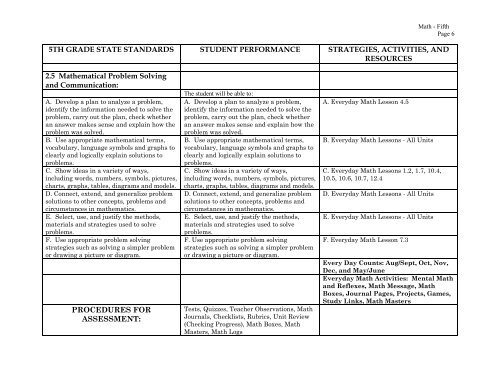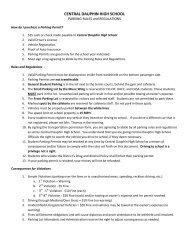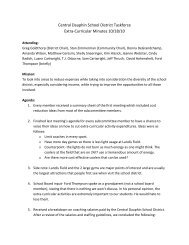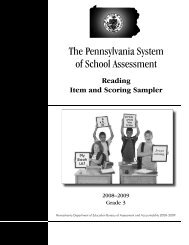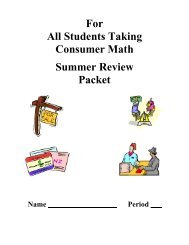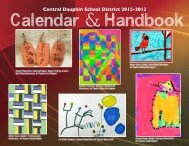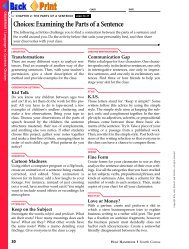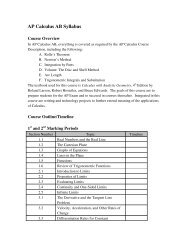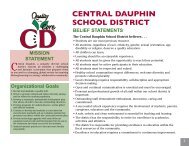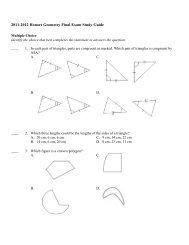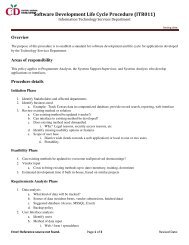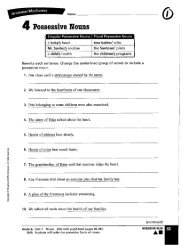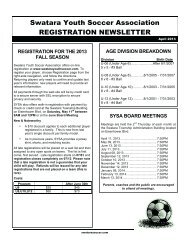Course Title: Math Grade Level: Fifth
Course Title: Math Grade Level: Fifth
Course Title: Math Grade Level: Fifth
Create successful ePaper yourself
Turn your PDF publications into a flip-book with our unique Google optimized e-Paper software.
<strong>Math</strong> - <strong>Fifth</strong><br />
Page 6<br />
5TH GRADE STATE STANDARDS STUDENT PERFORMANCE STRATEGIES, ACTIVITIES, AND<br />
RESOURCES<br />
2.5 <strong>Math</strong>ematical Problem Solving<br />
and Communication:<br />
A. Develop a plan to analyze a problem,<br />
identify the information needed to solve the<br />
problem, carry out the plan, check whether<br />
an answer makes sense and explain how the<br />
problem was solved.<br />
B. Use appropriate mathematical terms,<br />
vocabulary, language symbols and graphs to<br />
clearly and logically explain solutions to<br />
problems.<br />
C. Show ideas in a variety of ways,<br />
including words, numbers, symbols, pictures,<br />
charts, graphs, tables, diagrams and models.<br />
D. Connect, extend, and generalize problem<br />
solutions to other concepts, problems and<br />
circumstances in mathematics.<br />
E. Select, use, and justify the methods,<br />
materials and strategies used to solve<br />
problems.<br />
F. Use appropriate problem solving<br />
strategies such as solving a simpler problem<br />
or drawing a picture or diagram.<br />
PROCEDURES FOR<br />
ASSESSMENT:<br />
The student will be able to:<br />
A. Develop a plan to analyze a problem,<br />
identify the information needed to solve the<br />
problem, carry out the plan, check whether<br />
an answer makes sense and explain how the<br />
problem was solved.<br />
B. Use appropriate mathematical terms,<br />
vocabulary, language symbols and graphs to<br />
clearly and logically explain solutions to<br />
problems.<br />
C. Show ideas in a variety of ways,<br />
including words, numbers, symbols, pictures,<br />
charts, graphs, tables, diagrams and models.<br />
D. Connect, extend, and generalize problem<br />
solutions to other concepts, problems and<br />
circumstances in mathematics.<br />
E. Select, use, and justify the methods,<br />
materials and strategies used to solve<br />
problems.<br />
F. Use appropriate problem solving<br />
strategies such as solving a simpler problem<br />
or drawing a picture or diagram.<br />
Tests, Quizzes, Teacher Observations, <strong>Math</strong><br />
Journals, Checklists, Rubrics, Unit Review<br />
(Checking Progress), <strong>Math</strong> Boxes, <strong>Math</strong><br />
Masters, <strong>Math</strong> Logs<br />
A. Everyday <strong>Math</strong> Lesson 4.5<br />
B. Everyday <strong>Math</strong> Lessons - All Units<br />
C. Everyday <strong>Math</strong> Lessons 1.2, 1.7, 10.4,<br />
10.5, 10.6, 10.7, 12.4<br />
D. Everyday <strong>Math</strong> Lessons - All Units<br />
E. Everyday <strong>Math</strong> Lessons - All Units<br />
F. Everyday <strong>Math</strong> Lesson 7.3<br />
Every Day Counts: Aug/Sept, Oct, Nov,<br />
Dec, and May/June<br />
Everyday <strong>Math</strong> Activities: Mental <strong>Math</strong><br />
and Reflexes, <strong>Math</strong> Message, <strong>Math</strong><br />
Boxes, Journal Pages, Projects, Games,<br />
Study Links, <strong>Math</strong> Masters


